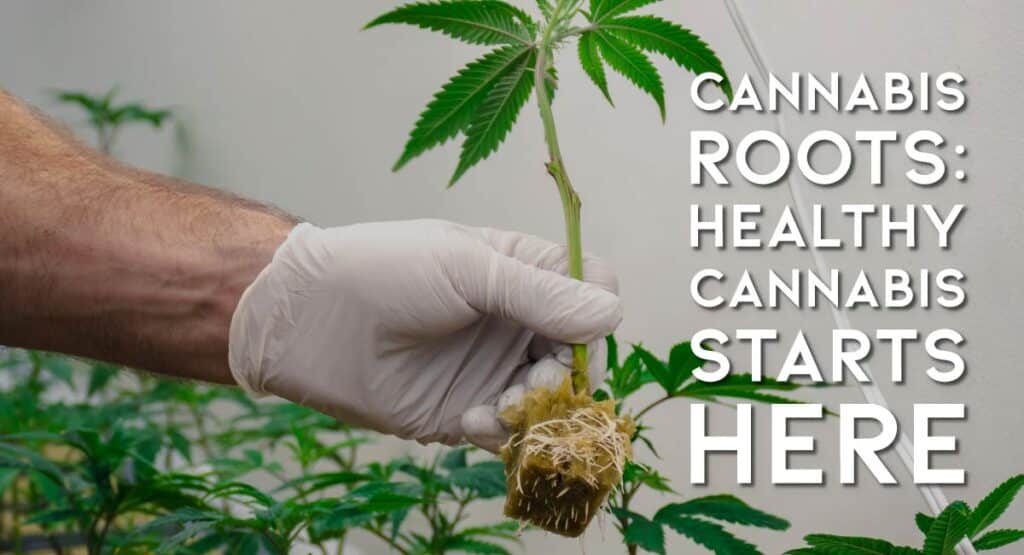Roots are an important part of a cannabis plant’s life cycle. They help the plant absorb water and nutrients from the soil, anchor it securely to the ground, and store energy that can be used during times of stress. But did you know that cannabis roots also have unique nutritional needs? If you want your plants to grow strong and healthy roots, then it’s important for their diet to include a variety of nutrients and vitamins.
While most growers may not pay much attention to cannabis roots after harvest, they have a longstanding history of medicinal uses. Let’s dive into the world of cannabis roots and explore the magic within.
Healthy Cannabis Roots: What’s Inside?
The roots serve as a food supply for the rest of the plant, containing many nutrients and minerals. In fact, cannabis roots are a good source of vitamins A and C, calcium, phosphorus, and potassium. Although the roots of cannabis plants mostly consist of sugars and lipids, low levels of terpenes—as well as alkaloids (chemicals that are produced by many plant species) have also been isolated. What else is in there?
Cannabinoids
Studies suggest that there is some trace amount of cannabinoids in the roots of cannabis plants and that this level may be higher in certain strains. It is also believed to fluctuate depending on external conditions such as weather or location.
There are now various outlets in the United States selling powdered, “activated” cannabis root, purportedly for its high CBD concentrations. However, it appears that the concentration of CBD in this substance is very low—so even if you have access to it, your money may be better spent on traditional products
Triterpenoids
Chemical compounds composed of three terpene units are known as triterpenoids. Friedelin and epifriedelanol are two of the most commonly found triterpenoids in cannabis roots. Friedelin is thought to have protective and antioxidant effects on the liver. Pentacyclic triterpene ketones from epifriedelanol have been shown to induce apoptosis in cancer cells and reduce inflammation, pain, and bacteria infections—and possess diuretic properties.
Alkaloids
Cannabis roots have been found to contain several alkaloids that may be medically useful—for example, piperidine and pyrrolidine. Piperidine, a chemical used as a building block for several pharmaceuticals, is particularly important in psychiatric medicine. Pyrrolidine can also be synthesized into racetams—a class of stimulant drugs known to have powerful nootropic effects on human beings.
Alkaloids can be toxic in high doses, but they also have various medical benefits if taken at lower concentrations.
Choline
Cannabis root contains small amounts of choline and atropine—both compounds found in plants. Choline is an essential nutrient and the precursor to a neurotransmitter called acetylcholine—thought to be crucial for normal cell membrane function.
Medicinal Uses of Cannabis Roots
We know that cannabis is one of the most potent and multifaceted medicinal plants on the planet. It has been used for centuries to treat and prevent various ailments. Today, we primarily focus on the flowers, though sometimes we use leaves and stalks for medicinal purposes. The entire plant contains beneficial compounds, and as we know from studying the entourage effect, the whole plant works best together.
Pliny the Elder recorded medicinal uses of cannabis roots in The Natural History, and we have him to thank for much of our historical record of this subject matter.
- Gout
- Arthritis
- Joint pain
- Inflammation
- Tumors
- Burns
- Postpartum hemorrhage
- Sexually transmitted diseases
- Gastrointestinal health
- Various infections
So, if you’re wondering how to use cannabis roots, there are plenty of ways!
Today, those using cannabis roots typically brew them into a tea with other medicinal herbs or use them to make topicals like slaves, balms, and lotions. Not many dispensaries are well stocked with cannabis root products, so you may need to do a little more research to find specialty products.
Understanding Cannabis Roots
Cannabis will never reach its full potential with an unhealthy root system. It might seem like the roots support an ‘out of sight, out of mind’ mentality, but it’s critical that a grower pay attention to root vitality. We have all of your cannabis roots questions answered here.
How do cannabis roots grow?
Cannabis roots grow in a pyramid shape; the taproot grows vertically down into the ground, while offshoots and their capillaries tend to spread out horizontally.
How deep do cannabis roots grow?
This mostly depends on the size of the container, but they can grow up to 3 feet in length! The main purpose of cannabis root growth is to provide support for the plant while it grows and develops its buds.
How fast do cannabis roots grow?
While you may be surprised to learn that cannabis roots grow much more slowly than the rest of your plant, their growth rates are still not all that slow. On average, they will reach between 0.5 – 1 inch per week and can reach up to 3 inches at their fastest. This means that it will take a little over 2 months for your plant’s root system to be fully formed and ready for transplanting (or harvesting).
Do cannabis roots grow during flowering?
Yes, cannabis roots grow during flowering. They will continue to grow as long as they are fed and watered.
Do cannabis plant roots have THC?
Cannabis roots do not contain THC. Instead, they produce cannabidiol (or CBD). The leaves and flowers of cannabis plants contain both CBD and THC, but the roots have no psychoactive properties.
Do cannabis roots need aeration?
Yes, roots need both air and water to thrive. Without sufficient access to oxygen, roots cannot uptake nutrients.
How do you know if your cannabis roots are unhealthy?
Cannabis roots are milky white and full, like a healthy head of hair. Brown, soggy roots are a sign of root rot. This brown slime suggests that your roots are likely beyond repair. The best way to prevent root rot is by reducing watering or making sure that your plants dry out between watering.
If you can’t see the roots, look at the leaves. Yellow or browning leaves can signal a nutrient or mineral deficiency in the root system.
Whole Plant Health Starts with the Root
Healthy roots lead to healthy stalks lead to healthy buds. It all starts here. At URSA, we value every part of the life cycle. We also know that the healthiest roots are growing in the natural terroir of Humboldt County. It’s here that sungrown cannabis stretches its roots deep below the surface of the nutrient-rich soil.
We work with farmers in this region because of their dedication to craft cannabis, and we are so fortunate to extract our concentrates from these robust, healthy plants! Shop our entire collection, knowing that the quality begins underground.




